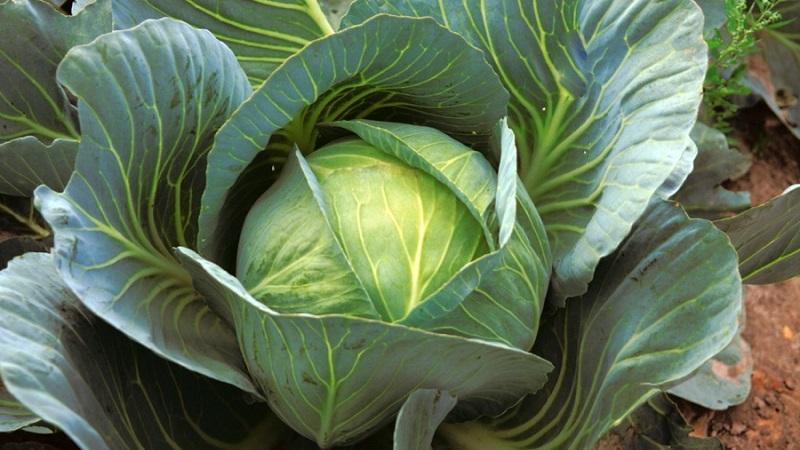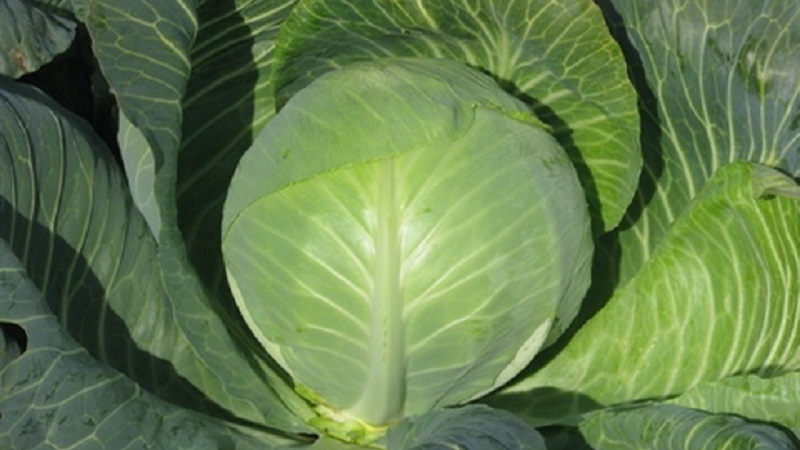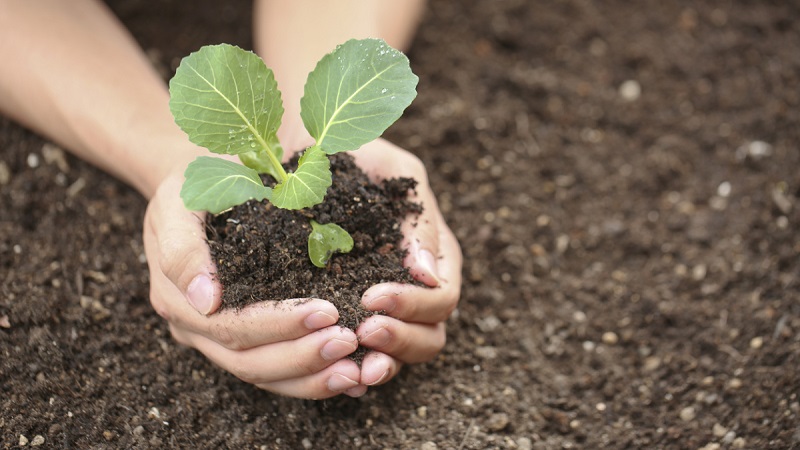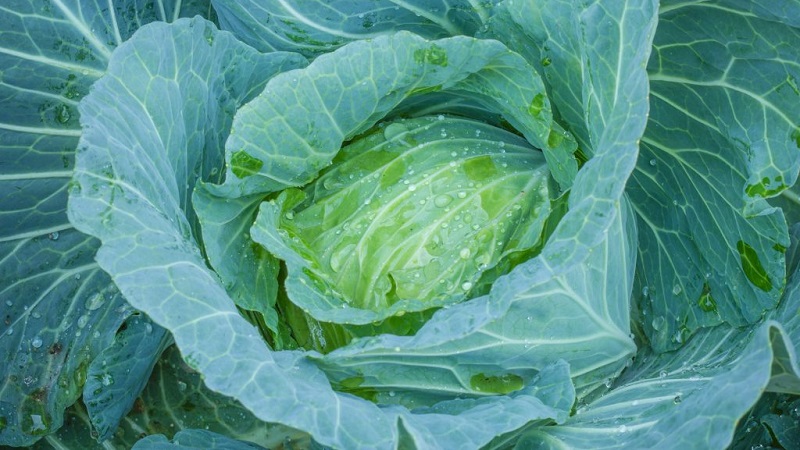Unpretentious late ripe cabbage hybrid Prestige f1
Gardeners often prefer late-ripening cabbage so that the harvested crop is stored for a long time. In this article, we will tell you in detail about one of the popular late-ripening hybrids Prestige f1, its advantages, disadvantages and cultivation features.
The content of the article
Description of cabbage hybrid Prestige f1
Prestige f1 - a hybrid of domestic selection of white cabbage, which forms round, dense forks with juiciness and pleasant sweet taste.
Breeding history
The hybrid was bred by a breeder of the Russian State Agrarian University named after V.I. K. A. Timiryazeva G. F. Monakhos.

Chemical composition, trace elements and vitamins, useful properties
Cabbage is good for the body. 100 g of vegetable contains:
- vitamin PP - 0.7 mg;
- vitamin K - 76 mcg;
- vitamin E - 0.15 mg;
- vitamin B6 - 0.124 mg;
- vitamin B1 - 0.061 mg;
- vitamin A - 0.03 mg;
- ascorbic acid - up to 45 mg;
- calcium - up to 48 mg;
- magnesium - 16 mg;
- phosphorus - up to 31 mg;
- potassium - 170 mg;
- sodium - 18 mg.
Eating cabbage minimizes the risk of developing atherosclerosis, improves the functioning of the digestive system, helps in the treatment of gastric and duodenal ulcers, insomnia, headaches. Cabbage leaves help with edema, inflammatory processes of the skin, cardiovascular diseases, high cholesterol levels, and joint pain.
Application features
F1 Prestige consumed fresh, fermented, salted, canned, used for the preparation of snacks and vegetable salads... Heads of cabbage endure heat treatment without loss of taste, so cabbage is boiled, stewed and fried.
Ripening period and yield
This is a late-ripening hybrid. After the emergence of mass shoots, 160-170 days pass before the onset of technical maturity of the crop., from planting seedlings in open ground - about 125 days.
Marketable yield - 328-660 kg / ha. The output of marketable products is 94%.
Reference. The maximum yield was recorded in the Ivanovo region - 699 c / ha.
Disease, pest and cold resistance
Cabbage Prestige f1 is resistant to fusarium wilt, Alternaria and thrips... Moreover, it can be affected by white and gray rot, cabbage flies, whites, scoops, moths, bears, cruciferous fleas.
Hardened seedlings tolerate a short drop in air temperature down to -3 ... -5 ° C.
Characteristics, description of the appearance of leaves and head of cabbage, taste
The hybrid is characterized by dense rounded heads of cabbage weighing 2-2.6 kg, individual specimens weigh up to 3.5 kg. Sectional view of white cabbage. The length of the inner stump is 6 cm, the outer one is 15 cm.

The leaf rosette is raised, reaches 90 cm in diameter... Leaves are medium in size, slightly bubbly, with slightly wavy edges, light green with a gray tint and covered with a thick layer of waxy coating.
Cabbage to taste sweet and juicy.
Growing regions and climate requirements
Hybrid Prestige f1 included in the State Register of Russia with admission to growing in North-West, Central, Ural, West Siberian and Central Black Earth regions.
Advantages and disadvantages of the Prestige f1 hybrid
The main virtues of culture:
- good commercial qualities;
- the possibility of mechanized harvesting;
- high seed germination and productivity;
- excellent taste and juiciness of heads of cabbage;
- the ability to adapt to the climatic conditions of different regions;
- no tendency to cracking, even in dry periods;
- long-term storage of the crop;
- immunity to cultural diseases;
- amicable ripening, density and good transportability of heads of cabbage;
- suitability for commercial cultivation;
- versatility of use.
No disadvantages of this hybrid have been identified..
Difference from other varieties and hybrids
Comparison of Prestige f1 with other late maturing hybrids:
| Hybrid | Head shape | Head of cabbage weight, kg | Productivity, c / ha |
| F1 Prestige | Rounded | 2-2,6 | 328-660 |
| Jubilee f1 | Rounded | 2-2,7 | 327-576 |
| Extra f1 | Flat-rounded | 2,5-2,8 | 398-424 |
| Exp f1 | Rounded | 1,9-3 | 278-600 |
Features of planting and growing
The hybrid is cultivated in open and closed ground... For plants to grow and develop well, it is recommended to grow this cabbage seedling method.

Preparing for planting seeds and seedlings
Seeds for seedlings are sown from mid-March to late April, given that it is transplanted into the ground when the sprouts are 40-45 days old.
The soil is spilled in advance with a solution of potassium permanganate or fungicide (for example, "Maxim") for disinfection. Before sowing, the planting material is soaked in a solution of potassium permanganate for 20-40 minutes, then washed and dried. This improves its germination and provides additional protection against diseases and pests.
Reference. A suitable substrate for sowing seeds consists of peat, garden soil, river sand and ash.
The soil is poured into a prepared container and the seeds are laid out on its surface, deepening by about 1.5-2 cm and maintaining a distance between the grains of at least 1 cm.
Then the container is covered with polyethylene to create a greenhouse effect and cleaned in a warm place before germination, regularly watering the ground and airing the greenhouse. After germination of seeds in the room with seedlings, the air temperature is maintained at + 14 ... + 17 ° C during the day and + 12 ° C at night. If the seedlings grow thin and stretch out, the temperature is lowered for a week to + 6 ... + 7 ° C.
2-3 weeks before transplanting into the ground, the seedlings begin to harden... To do this, a container with seedlings is taken out into the street or balcony, first for 20-30 minutes, then for 2-4 hours, on the last day the seedlings are not taken indoors.
How to make a seedless plant
In regions with a warm climate, it is permissible to grow a Prestige f1 hybrid without seedlings - by sowing seeds in closed ground. To do this, in late April - early May, they are sown in a film greenhouse at an air temperature of + 15 ... + 17 ° C at a distance of 40-50 cm from each other, deepening by 1.5-2 cm.
Ground requirements
Cabbage planted in a well-lit area protected from gusty winds... The hybrid prefers loose, fertile soil with low to neutral acidity.
Predecessors
F1 Prestige not planted after arugula, radish, radish and cruciferous "brothers"... The best predecessors are onions, peas, beans, potatoes, garlic, beans, carrots.
Reference. According to the rules of crop rotation, the crop can be planted in the same place after at least 4 years.
Timing, scheme and landing rules
Seedlings are transplanted into open ground in May - early Junewhen she is 40-45 days old. At the time of transplanting, seedlings should have 4-5 true leaves.
Landing scheme:
- Form in the prepared area rows for planting cabbage.
- Dig planting holes in them with a diameter of 60 cm and a depth of 50 cm.
- Pour mineral fertilizers into each, and in the case of depleted soil, also humus or compost.
- Remove the plants from the container and place in the prepared wells.
- Sprinkle with earth so that the seedlings go deep to the first true leaf.
- Water and mulch the soil.
Allowable stocking density - 4-5 plants per 1 sq. m.

The nuances of care
The hybrid does not have special care requirements, however compliance with the basic agrotechnical requirements of the crop is a prerequisite for obtaining a plentiful and high-quality harvest.
Watering mode
Plants are watered based on climatic conditions and soil conditions - it should not dry out or be waterlogged. On average, watering is carried out every three days, in dry weather - daily, pouring water under the root.
Reference. For irrigation, use water warmed up to at least + 20 ° C.
Watering is stopped a week before harvestto make heads of cabbage better were kept.
Loosening and hilling
To improve the access of moisture and oxygen to the roots and to exclude the likelihood of the formation of a dry crust on the surface of the soil, a day after each watering or rain, the ground is loosened to a depth of 5-8 cm. Weeds are removed at the same time.
So that the heads of cabbage do not fall to one side, the plants are spud twice a season - about three weeks after transplanting the seedlings into the ground and again after 10-15 days.
Top dressing
Fertilizers for cabbage are applied at least four times per season according to the scheme:
- 20 days after transplanting seedlings into the ground - a solution of superphosphate and ash (60 g and 200 g, respectively, for 10 liters of water);
- after 10-15 days - watering 2 tbsp. l. "Nitrofoski" diluted in 10 liters of water;
- after 10 days - a solution consisting of 10 liters of water, 1 kg of manure and 2 g of superphosphate;
- 20 days before harvesting - 40 g of potassium sulfate, diluted in 10 liters of water.
Measures to increase the yield
The most powerful way to increase yields - regularly feed the plants using organic (mullein solution) and mineral (with a high content of phosphorus and potassium) fertilizers.
It is especially important to use dressings after transplanting seedlings into the ground and during the ripening of heads of cabbage.
Disease and pest control
Diseases and pests that threaten the Prestige f1:
| Disease, pest | Signs | Treatment, prevention |
| White rot | Heads of cabbage are covered with white spots and gray bloom. | For the prevention of diseases, wood ash is introduced into the planting holes. Plants are treated with preparations "Baktofit", "Planriz", "Fitolavin". |
| Gray rot | Brown spots appear on the cabbage, which gradually increase in size, get wet, become covered with mucus and a gray bloom. | |
| Cabbage fly | Plants develop slowly, the leaves turn blue-lead and dry out. | In the event of an attack by these pests, I use complex insecticidal preparations, for example, "Aliot", "Mukhoed", "Sempai". |
| Belyanka | On the inside of the leaves, eggs of butterflies are noticeable, caterpillars gnaw through leaves and heads of cabbage, leaving behind a dark green discharge. | |
| Scoop | ||
| Moth | Young plants die as insects damage the central rosettes. | |
| Medvedka | Pests damage the roots of plants, which is why they rapidly wither and die. | |
| Cruciferous flea | Ulcers form on cabbage, plant tissues die off. |
The use of pesticides is unacceptable during and after head formation... In this case, folk remedies are used - solutions of soap (300 g per 10 l of water) or wood ash (10 l of water, 110 g of ash, 110 g of soap, 20 g of urea to insist for two days).

Growing difficulties
Problems when cultivating a hybrid:
- plants do not develop well, disappear, roots rot - due to waterlogging of the soil, the root system rots;
- the heads of cabbage grow loose, the leaves on them are too small - the plants receive little light.
Harvesting and storage
Harvested at the end of August - September, on a dry and warm day, pulling heads of cabbage out of the ground.
Harvested crop laid out under a canopy for drying, inspected and sorted... Suitable for storage only dense heads of cabbage without signs of disease and damage. Unsuitable specimens are thrown away or discarded for prompt use.
Store cabbage in a dark, well-ventilated room at a temperature not higher than + 2 ° C and air humidity of about 90%. In such conditions, heads of cabbage retain marketability and taste for seven months or more.
Interesting on the site:
Prestige f1 cabbage tips and reviews
Farmers recommend:
- plant cabbage in a well-lit area - heads of cabbage develop worse in the shade;
- but at the same time, make sure that the plants are not exposed to direct sunlight.
Gardeners speak positively about the hybrid.
Irina, Volzhsky: “I grow this cabbage especially so that there is a fresh vegetable in winter - Prestige has a wonderful and long shelf life. But this, of course, is not the only plus of the hybrid. I like the taste of the heads, the yield and the fact that when grown on fertile soil, the heads grow large - 3 kg each ".
Svetlana, Samara: “Among the late-ripening varieties that I tried to grow, I chose Prestige. I liked its yield, disease resistance and unpretentious care. The heads of cabbage are beautiful, large and tasty, they are stored perfectly, almost until April ".
Conclusion
Prestige f1 is a high-yielding cabbage hybrid that has no drawbacks. It is resistant to common diseases, is able to adapt to various climatic conditions, is characterized by long-term storage and universal use of heads.